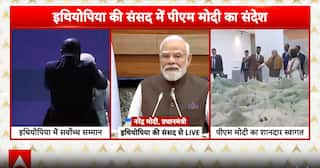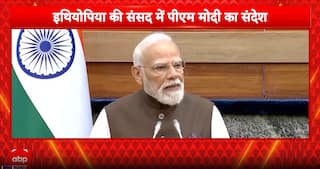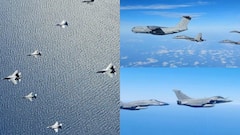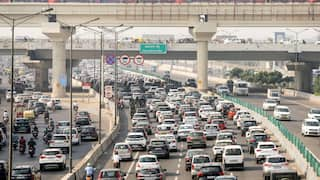India-Middle East-Europe Corridor Vs China's BRI: How Big A Challenge Is IMEC To BRI And How It Will Shape Up
The India-Middle East-Europe Corridor, or IMEC, presents a possible threat to China's BRI, as it has the potential to divert supply chains from China to India-Arab and European conglomerates.

The Middle East is witnessing a paradigm change in their world as old foes are turning into friends, and hitherto unthinkable political alliances are rapidly changing the region's economic equations. The multilateral connectivity project linking countries — from India to the European continent — with the unveiling of the India-Middle East-Europe Economic Corridor (IMEC) is one such example. The benefits of this project would not only be limited to the region alone, but will have wider geostrategic and geoeconomic implications. After two millennia, the Asia-Arabian Gulf and European region once again hopes to be in the centre of a revived ancient Red Sea trade route, linking the Roman Empire and India, which flourished during 30 BCE and continued till the middle of the second millennium.
Hence, from the coasts of India to Arabian Sea and Red Sea, and then on to the Mediterranean, ripples were felt as India along with the US, the UAE, Saudi Arabia, France, Germany, Italy, and the European Union signed an MoU, and announced the very ambitious plan of sea and land connectivity on “spice trade route”. The linkages by “ports, rail-road and ports” network spanning from Indian ports to Persian ports, connecting to the Egyptian ports and then on to the European railroad line terminating at the Mediterranean seaports, will hugely reduce the transport time and cost. It was natural for the critics of Chinese Belt and Road Initiative (BRI) to rejoice at the prospects of throwing a real challenge to the Chinese infrastructure network across the continents with over 100 memberships.
Announced on the sidelines of the G20 Leaders' Summit held in New Delhi on September 9-10, the IMEC presents a possible threat to China's 'Belt and Road Initiative', or the BRI, as it has the potential to divert supply chains from China to India-Arab and European conglomerates, who have taken this initiative to connect the missing links, which existed in ancient times between Roman and Indian ports through the Egyptian port of Alexandria. Theoretically, the IMEC would be a revival of the ancient trade route, also called the Spice Route or Maritime Silk Road, because of main exports of spices and other regional products and crafts from the Indian subcontinent connecting the Mediterranean ports.
Before announcing this ambitious connectivity plan, the US administration had tried to generate an amicable political ecosystem by creating a web of alliances with its Middle East partners like the I2U2 (India, Israel, UAE and USA). These US promoted alliances would facilitate the US to continue its presence and influence, which of late has seen gradual erosion. Continued US presence in the region may ensure effective implementation of the project.
ALSO READ | G20 Done. Joint Statement Hailed. Time Now To Focus On India’s North And West Borders
IMEC — Concept, Origin, And Objective
The IMEC is a brainchild of the Partnership for Global Infrastructure Investment (PGII), which was first announced at the initiative of the US and its western alliance partners during the June 2021 G7 Summit held in the UK. Next year, during the Germany 2022 G7 Summit, the PGII was officially launched. President Joe Biden had earlier announced the setting up of Build Back Better World (B3W) framework, but it could not see much progress. At the June 2022 Germany summit, the PGII was officially launched as a joint initiative to finance infrastructure development plans through public and private partnerships.
President Biden had then announced on X (formerly twitter): “Collectively we aim to mobilise USD 600 billion from the G7 by 2027 to invest in critical infrastructure that improves lives and delivers real gains for all of our people."
There is a major difference between the BRI and the PGII. The PGII is a multilateral funding initiative with public and private partnerships, whereas BRI is a single country owned infrastructure project with direct funding from Chinese development Banks and the project executed only by Chinese companies.
PGII thus claims to present an alternative model of project execution with stakes of various parties. This is expected to ensure the economic viability of the projects. Since the infrastructure will be passing through countries, close cooperation between them would be sine qua non. In view of the unstable state of relations between various Middle East powers, there would always be a risk of adverse impact on smooth management of port-rail-port transfer of goods.
Though no time limit has been announced, the project seems to be at the conceptual stage. So, it would be too far-fetching to say that the IMEC will soon throw a big challenge to the decade-old BRI, which has learnt lessons from its previous funding pattern and may recast its funding policy to allay the concerns of partner countries.
The promoters of PGII aver that its projects would be transparent, focussed on building climate change-resilient infrastructure, and help in achieving the objectives of gender equality and health infrastructure development.
Interestingly, China has reacted positively to the announcement of the IMEC project, saying: “China continues to welcome all initiatives to promote global infrastructure development, but we are opposed to pushing forward geo-political calculations under the pretext of infrastructure construction or smearing the Belt and Road Initiative.”
At present, all goods movements from the Arabian Sea to the Mediterranean occur through Suez Canal, which remains mostly congested causing much longer time than the proposed IMEC project offers. When the IMEC project becomes operational, it would make transport of Indian goods much cheaper, thus posing a competition to Chinese goods in the Middle East and European countries, besides the African market. India can hope to be a Chinese alternative to the supply chain, thus fulfilling the US desire to reduce its total dependence on Chinese suppliers.
ALSO READ | India And Russia: Time-Tested Strategic Relationship Navigating Uncertain Waters
How The IMEC Will Shape Up
The IMEC is based on two separate corridors — Eastern Corridor connecting India-West Asia, and Northern Corridor connecting West Asia to Europe. The connectivity project is based on rail lines, which after completion will provide a reliable and cost-effective cross-border ship to rail transit network to supplement the existing multimodal transport routes, enhancing the transhipment of goods and services across South East Asian country through India to West Asia to Middle East Europe. Observers expect India to gain a lot as the project places the country significantly on the route of trade flows from South East Asia. As the rail lines would be passing through various countries, it would require formulation of integrated customs and tariff regimes.
Though the ambitious IMEC connectivity project has huge potentials of accelerating the economy of all linked countries, it has equally strong challenges also. Acknowledging the huge challenges in its implementation on the ground, Crown Prince of Saudi Arabia Mohammad Bin Salman said in New Delhi: “The project would require hard work and cooperation by all. We would have to work diligently to make it a reality.”
Undoubtedly, the multi-billion dollar project holds great promises, but has equally tough challenges to overcome. To fast track the project implementation, it would require member states to clear all roadblocks instantly that would emerge during the course of its implementation. To resolve issues, the member countries would have to form a high-level taskforce and a monitoring committee to work on a fixed timeline. The success of IMEC would encourage PGII to undertake projects of similar scale and then present a real challenge to China's BRI.
(The author is a senior journalist and strategic affairs analyst.)
Disclaimer: The opinions, beliefs, and views expressed by the various authors and forum participants on this website are personal.







































